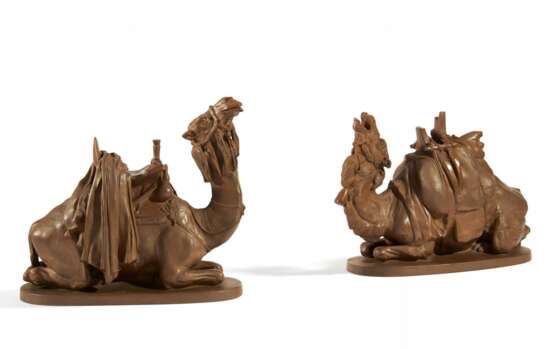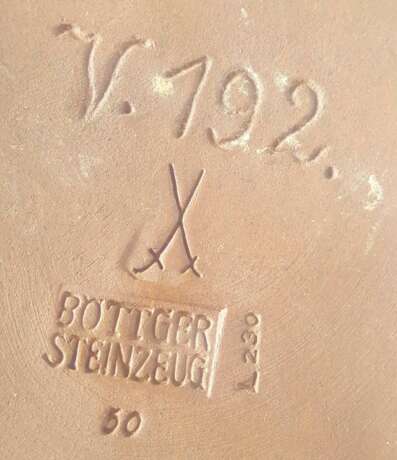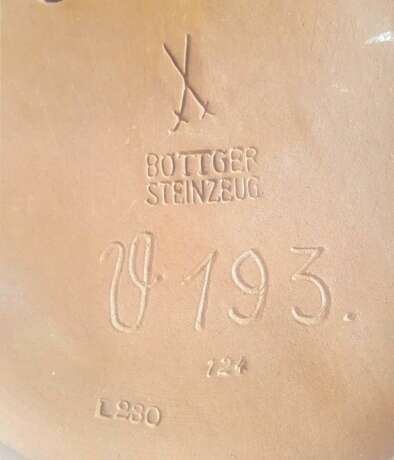ID 252382
Lot 36 | Dromedar als Reittier und Trampeltier als Lastenkamel
Estimate value
€ 6 000 – 8 000
Böttgersteinzeug, partiell poliert. Beide Tiere sind liegend dargestellt. Das Dromedar trägt ein mit Fransen behängtes Halfter und einen Sattel auf den Rücken geschnallt. Über diesen ist ein langes Tuch drapiert, das an der Seite des Tieres herabfällt. Am Knauf hängen eine Kürbisflasche und ein Instrument.
Das Trampeltier ist an seinem langen, dichten Fell zu erkennen. Es trägt einen Zaum mit Glocke um den Hals und einen Packsattel. Es hat den Kopf nach hinten geneigt und sein Maul geöffnet, als würde es einen Ruf ausstoßen. Höhe 42cm, Breite ca. 47,5cm / Höhe 35,5cm, Breite ca. 53,5cm.
Schwertermarke und "Böttger Steinzeug", V192/V193, Bossierernr. 50/124, beide mit Prägestempel L230. Zustand A bzw. A/B.
Provinienz:
Persönliche Schenkung von Erich Hösel. Durch Erbgang bis heute in Familienbesitz.
Literatur:
- Marusch-Krohn, Caren: Meissener Porzellan 1918-1933. Die Pfeifferzeit, Leipzig 1993, zu Böttgersteinzeug S.18-20; zu Erich Hösel S.154.
- Bröhan, Karl H. (Herausgabe:) Porzellan, Kunst und Design 1889-1939, vom Jugendstil zum Funktionalismus, Bestandskatalog Bd.V.2 des Bröhan-Museums, Berlin, 1996. Zu Tierplastik in Meissen siehe S.65.
Es war im März 1709, als Johann Friedrich Böttger, in einer Mitteilung an August den Starken, die Erfindung des "rothen porcellain" und des begehrten "weißen porcellain", verkünden konnte. Das rote Feinsteinzeug, nach seinem Erfinder 'Böttgersteinzeug ' benannt, wurde vor allem für die Herstellung von Gefäßen genutzt, die als erste Erzeugnisse der 1710 gegründeten Meissner Porzellanmanufaktur verkauft werden konnten. Das aufwändige Produktionsverfahren, sowie die ästhetische Vorliebe des 18. Jahrhunderts für weißes Porzellan führten jedoch dazu, dass das rote Steinzeug schnell in Vergessenheit geriet. Bereits 1741 wird es in den Rezeptbüchern der Manufaktur nicht mehr erwähnt.
Erst Anfang des 20. Jahrhunderts unternahm man in Meißen erste Versuche, die Zusammensetzung und Herstellung des Böttgersteinzeuges neu zu erforschen. Die Reproduktion eines nahezu identischen Scherbens gelang schließlich 1919, unter der Generaldirektion von Max Adolf Pfeiffer. Es ist seinem Engagement zu verdanken, dass das Böttgersteinzeug an der Manufaktur im Jugendstil eine Renaissance erlebte. Pfeiffer bemühte sich für neue Modelle um die Mitarbeit bekannter Künstler, die neben Münzen, Medaillen und Plaketten auch Figuren und vor allem Tierplastiken in Böttgersteinzeug entwarfen.
Neben bekannten Modelleuren wie August Gaul oder Max Esser, beschäftigte sich auch der seit 1903 als Gestaltungsleiter an der Manufaktur tätige Erich Hösel mit dem wiederentdeckten Werkstoff. Hösels Einflussnahme als Gestaltungsvorsteher war es zu verdanken gewesen, dass Meissen Anfang des 19. Jahrhunderts im Bereich der Tierplastik zur führenden deutschen Manufaktur avancierte. Das Genre erfreute sich im Jugendstil einer bis dato ungekannten Beliebtheit, nachdem es in Kopenhagen wiederentdeckt und neu interpretiert worden war. Hösel erkannte das Potential der Dänischen Entwürfe und begann mit dem Aufbau einer eigenen Meissner Menagerie
| Manufactur: | Meissen Porcelain Factory |
|---|---|
| Auction house category: | Art Nouveau / Art Deco |
| Manufactur: | Meissen Porcelain Factory |
|---|---|
| Auction house category: | Art Nouveau / Art Deco |
| Address of auction |
VAN HAM Kunstauktionen GmbH Hitzelerstr. 2 50968 Köln Germany | ||||||||||||||
|---|---|---|---|---|---|---|---|---|---|---|---|---|---|---|---|
| Preview |
| ||||||||||||||
| Phone | +49 221 92586215 | ||||||||||||||
| Fax | +49 221 92 58 62 4 | ||||||||||||||
| Buyer Premium | 32% | ||||||||||||||
| Conditions of purchase | Conditions of purchase | ||||||||||||||
| Business hours | Business hours
|





